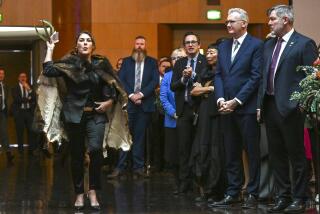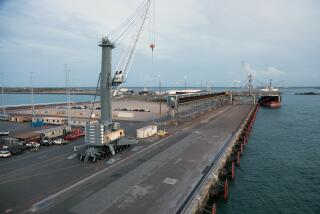Canberra’s Crisis of Confidence Is Capital Crime for Some Aussies
- Share via
CANBERRA, Australia — As the nation’s seat of power, Canberra is missing a vital component--someone to sit in it.
Since his election in 1996, Prime Minister John Howard has refused to live in Australia’s capital full-time.
In doing so, he has shirked a tradition that dates back to early in the city’s history and highlighted the malaise of Australia’s “bush capital.”
Carefully designed and meticulously planned to be the nation’s symbolic and literal seat of power, Canberra is struggling to confirm its place as Australia’s spiritual heart.
For decades one of Australia’s fastest-growing cities, a government boomtown of job security and relative affluence, Canberra now lags behind in economic growth and suffers a crisis of self-confidence.
Disheartened by deep cuts in public services, Canberrans fear that an exodus led by the conservative Howard is sending their city into decline.
Swept to power in a landslide election victory in March 1996, the Sydney-born Howard declined to move into the official prime ministerial residence, The Lodge, in Canberra.
He opted instead for a home overlooking the Sydney Harbor Bridge and Opera House, saying he didn’t want to disrupt his children’s schooling. Establishing a permanent office in Sydney, Howard spent 154 nights in Sydney and 123 in Canberra in his first year.
Canberrans were outraged, and critics say Howard’s refusal to move provided a focal point for the city’s gloom.
“If you take on the highest job in the land, you should be proud to live in The Lodge,” said Hans van de Zandt of a community group called the PM for Canberra Committee.
Jenny Eccles, president of the capital district’s branch of the Community and Public Service Union, said: “It’s started a downward spiral.”
The union estimates up to 10,000 Canberra jobs may be lost in cutbacks, retrenchments and sell-offs of government-owned businesses aimed at trimming the bureaucracy.
With most of the city’s 150,000 jobs in government agencies or businesses that cater to public servants, many of those who lose their jobs will move out of the city, Eccles predicts.
“You can already see it. Buses are not so full of people on the way to work. Schools are feeling the pinch,” she said.
Kate Carnell, who heads the local government of the Australian Capital Territory, a jurisdiction like the U.S. District of Columbia, said Howard’s decision to stay in Sydney was enormously damaging for the city.
“It is the national capital. Some people forget this is the face of Australia for many, many people,” she said.
Conceived when Australia’s divergent states federated in 1901, the site for the national capital was carved from the state of New South Wales and a new jurisdiction was created to quell provincial rivalries.
The 1,500-square-mile district lies roughly midway between Australia’s two largest cities, Sydney and Melbourne.
An American architect, Walter Burley Griffin, won a contest with a sweeping design for a lakeside city of stately buildings and monuments set in landscaped gardens. Construction began in 1913.
Growth was initially slow. Parliament House did not open until 1927, and the population in 1947 was just 15,000.
But, encouraged by a development commission, Australia’s only inland city exploded after World War II. By the 1990s, it had more than 300,000 residents.
National monuments including the National Library, War Memorial, High Court and Old Parliament House are set in parks built around Lake Burley Griffin.
The new Parliament, a huge building that is notable for its grass roof and its towering spire, dominates Capital Hill and is the centerpiece of a significant tourism industry.
Over-planning--including a network of eight-lane highways where more modest streets would clearly do, and an ordinance banning front yard fences--could be a metaphor for many Australians’ perception that Canberra is an administrative ivory tower.
Howard’s government hasn’t discouraged that view. Finance Minister John Fahey recently described the town as full of “third-generation public servants” who don’t really know what hardship is.
But the city has been hit hard by recession and a decline in its share of tax revenue from the federal government, on which it relies heavily for its budget.
Unemployment in the city is more than 8%, or around the national average. Applications for housing construction permits fell in September for the sixth consecutive month. Occupancy rates in hotels are down.
Concern about Canberra’s future has spurred the business community and local government to begin a campaign to attract new investment and tourism to the city.
The emphasis is away from politics and will promote the city as a center for technological excellence and high-quality education and as a tourist attraction.
“The power of Canberra goes far beyond politics,” Carnell said.
The campaign is at least in part a recognition that Canberra must show there is more to it than the business of government.
“With the dismantling of the federal public service, we have got to try and gear up and promote our city to keep as many people coming here as we can,” said Jim Murphy, chairman of the local Chamber of Commerce.
More to Read
Sign up for Essential California
The most important California stories and recommendations in your inbox every morning.
You may occasionally receive promotional content from the Los Angeles Times.










